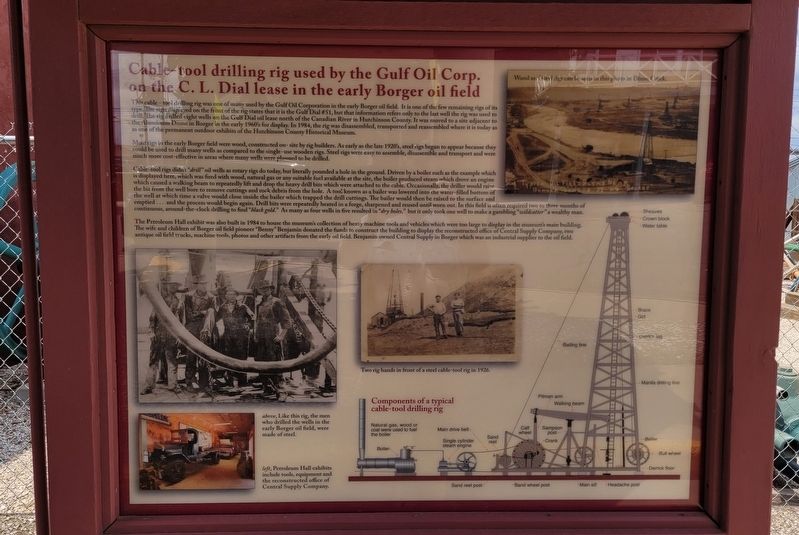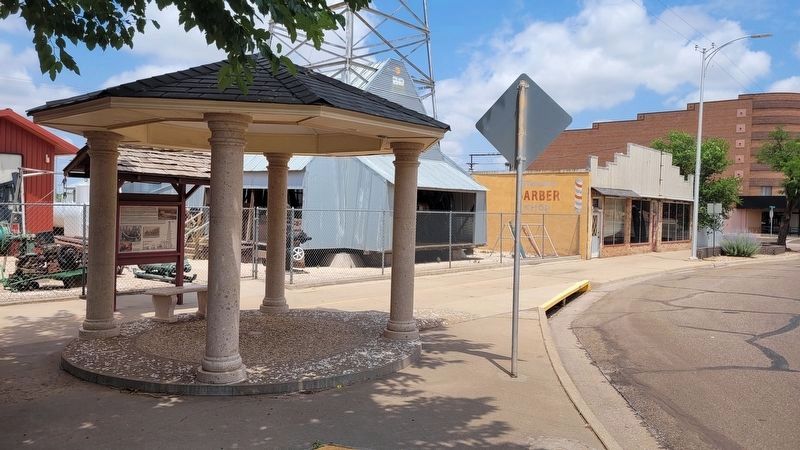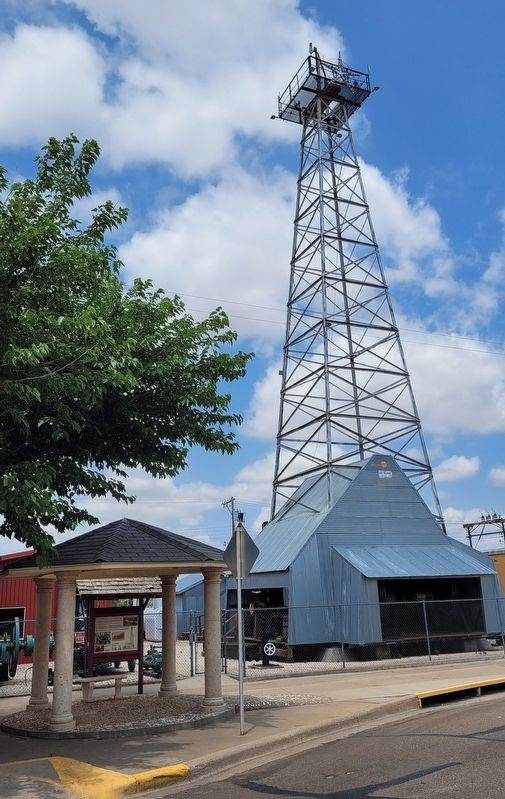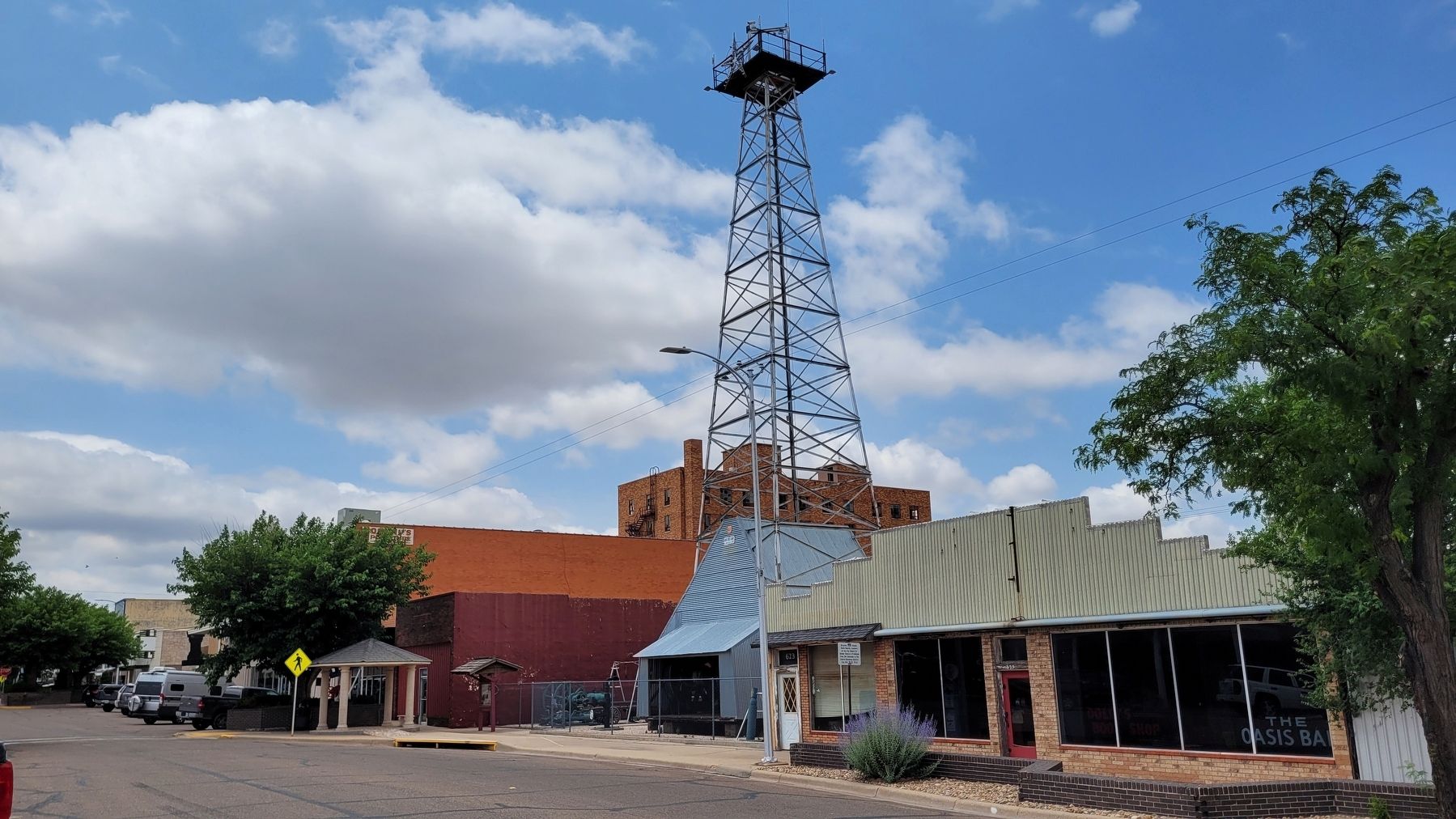Borger in Hutchinson County, Texas — The American South (West South Central)
Cable-tool drilling rig used by the Gulf Oil Corp.
Inscription.
Cable-tool drilling rig used by the Gulf Oil Corp. on the C. L. Dial lease in the early Borger oil field
This cable-tool drilling rig was one of many used by the Gulf Oil Corporation in the early Borger oil field. It is one of the few remaining rigs of its type. The sign displayed on the front of the rig states that it is the Gulf Dial # 51, but that information refers only to the last well the rig was used to drill. The rig drilled eight wells on the Gulf Dial oil lease north of the Canadian River in Hutchinson County. It was moved to a site adjacent to the Aluminum Dome in Borger in the early 1960's for display. In 1984, the rig was disassembled, transported and reassembled where it is today as as one of the permanent outdoor exhibits of the Hutchinson County Historical Museum.
Most rigs in the early Borger field were wood, constructed on-site by rig builders. As early as the late 1920's, steel rigs began to appear because they could be used to drill many wells as compared to the single-use wooden rigs. Steel rigs were easy to assemble, disassemble and transport and were much more cost-effective in areas where many wells were planned to be drilled.
Cable-tool rigs didn't "drill" oil wells as rotary rigs do today, but literally pounded a hole in the ground. Driven by a boiler such as the example which is displayed here, which was fired with wood, natural gas or any suitable fuel available at the site, the boiler produced steam which drove an engine which caused a walking beam to repeatedly lift and drop the heavy drill bits which were attached to the cable. Occasionally, the driller would raise the bit from the well bore to remove cuttings and rock debris from the hole. A tool known as a bailer was lowered into the water-filled bottom of the well at which time a valve would close inside the bailer which trapped the drill cuttings. The bailer would then be raised to the surface and emptied... and the process would begin again. Drill bits were repeatedly heated in a forge, sharpened and reused until worn out. In this field it often required two to three months of continuous, around-the-clock drilling to find "black gold." As many as four wells in five resulted in "dry holes," but it only took one well to make a gambling "wildcatter" a wealthy man.
The Petroleum Hall exhibit was also built in 1984 to house the museum's collection of heavy machine tools and vehicles which were too large to display in the museum's main building. The wife and children of Borger oil field pioneer "Benny" Benjamin donated the funds to construct the building to display the reconstructed office of Central Supply Company, two antique oil field trucks, machine tools, photos and other artifacts from the early oil field. Benjamin owned Central Supply in Borger which was an industrial supplier to the oil fields.
Captions
Middle Left: above, Like this rig, the men who drilled the wells in the early Borger oil field, were made of steel.
Lower Left: left, Petroleum Hall exhibits include tools, equipment and the reconstructed office of Central Supply Company.
Center: Two rig hands in front of a steel cable-tool rig in 1926.
Erected by Hutchinson County Historical Museum.
Topics. This historical marker is listed in this topic list: Industry & Commerce. A significant historical year for this entry is 1984.
Location. 35° 40.342′ N, 101° 23.403′ W. Marker is in Borger, Texas, in Hutchinson County. Marker is on North Main Street, 0.1 miles south of West 7th Street, on the right when traveling south. The marker is located in front of the drilling rig by the sidewalk. Touch for map. Marker is at or near this postal address: 618 North Main Street, Borger TX 79007, United States of America. Touch for directions.
Other nearby markers. At least 8 other markers are within walking distance of this marker. Grand Hotel and Grand Hardware Building (within shouting distance of this marker); Quanah Parker Trail (within shouting distance of this marker); Borger 1929 Jail (within shouting distance of this marker); Boomtown (within shouting distance of this marker); The Huber Paraffin Scraper (within shouting distance of this marker); Bessemer Gas Engine (within shouting distance of this marker); LeRoi Motor-Generator Set (within shouting distance of this marker); Allis-Chalmers/Cooper Winch Tractor (within shouting distance of this marker). Touch for a list and map of all markers in Borger.
Also see . . . Drilling rig. (Submitted on June 22, 2022, by James Hulse of Medina, Texas.)
Credits. This page was last revised on June 22, 2022. It was originally submitted on June 22, 2022, by James Hulse of Medina, Texas. This page has been viewed 127 times since then and 21 times this year. Photos: 1, 2, 3, 4. submitted on June 22, 2022, by James Hulse of Medina, Texas.



